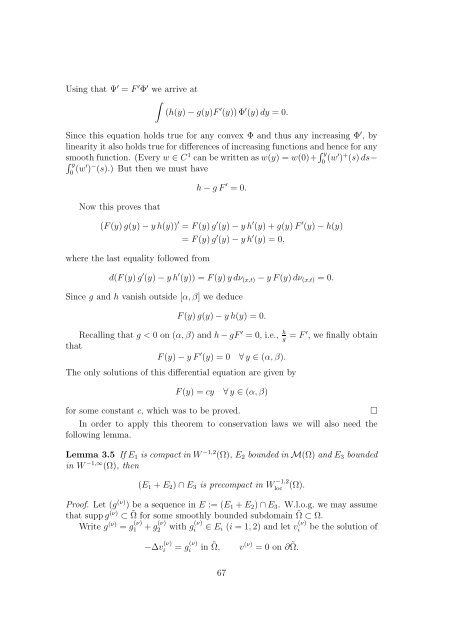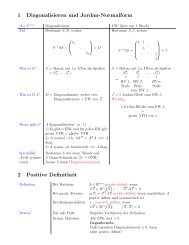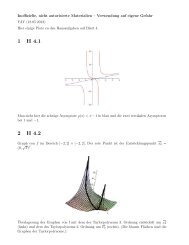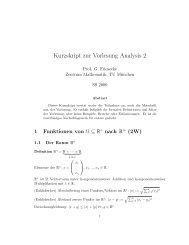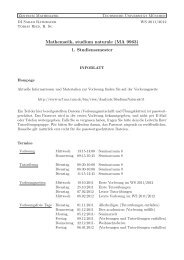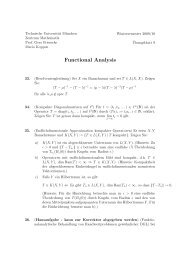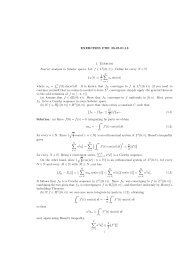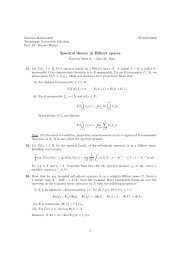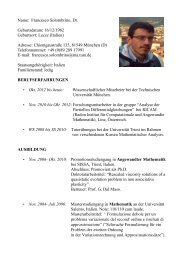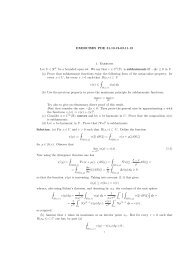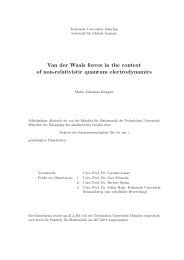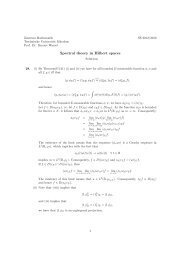Weak Convergence Methods for Nonlinear Partial Differential ...
Weak Convergence Methods for Nonlinear Partial Differential ...
Weak Convergence Methods for Nonlinear Partial Differential ...
Sie wollen auch ein ePaper? Erhöhen Sie die Reichweite Ihrer Titel.
YUMPU macht aus Druck-PDFs automatisch weboptimierte ePaper, die Google liebt.
Using that Ψ ′ = F ′ Φ ′ we arrive at<br />
∫<br />
(h(y) − g(y)F ′ (y))Φ ′ (y) dy = 0.<br />
Since this equation holds true <strong>for</strong> any convex Φ and thus any increasing Φ ′ , by<br />
linearity it also holds true <strong>for</strong> differences of increasing functions and hence <strong>for</strong> any<br />
smooth function. (Every w ∈ C 1 can be written as w(y) = w(0)+ ∫ y<br />
∫ 0 (w′ ) + (s) ds−<br />
y<br />
0 (w′ ) − (s).) But then we must have<br />
Now this proves that<br />
h − g F ′ = 0.<br />
(F(y) g(y) − y h(y)) ′ = F(y) g ′ (y) − y h ′ (y) + g(y) F ′ (y) − h(y)<br />
where the last equality followed from<br />
= F(y) g ′ (y) − y h ′ (y) = 0,<br />
d(F(y) g ′ (y) − y h ′ (y)) = F(y) y dν (x,t) − y F(y) dν (x,t) = 0.<br />
Since g and h vanish outside [α, β] we deduce<br />
F(y) g(y) − y h(y) = 0.<br />
Recalling that g < 0 on (α, β) and h −gF ′ = 0, i.e., h g = F ′ , we finally obtain<br />
that<br />
F(y) − y F ′ (y) = 0 ∀ y ∈ (α, β).<br />
The only solutions of this differential equation are given by<br />
F(y) = cy ∀ y ∈ (α, β)<br />
<strong>for</strong> some constant c, which was to be proved.<br />
In order to apply this theorem to conservation laws we will also need the<br />
following lemma.<br />
Lemma 3.5 If E 1 is compact in W −1,2 (Ω), E 2 bounded in M(Ω) and E 3 bounded<br />
in W −1,∞ (Ω), then<br />
(E 1 + E 2 ) ∩ E 3 is precompact in W −1,2<br />
loc<br />
(Ω).<br />
Proof. Let (g (ν) ) be a sequence in E := (E 1 + E 2 ) ∩ E 3 . W.l.o.g. we may assume<br />
that supp g (ν) ⊂ ˜Ω <strong>for</strong> some smoothly bounded subdomain ˜Ω ⊂ Ω.<br />
Write g (ν) = g (ν)<br />
1 + g (ν)<br />
2 with g (ν)<br />
i ∈ E i (i = 1, 2) and let v (ν)<br />
i be the solution of<br />
−∆v (ν)<br />
i<br />
= g (ν)<br />
i in ˜Ω, v (ν) = 0 on ∂˜Ω.<br />
□<br />
67


